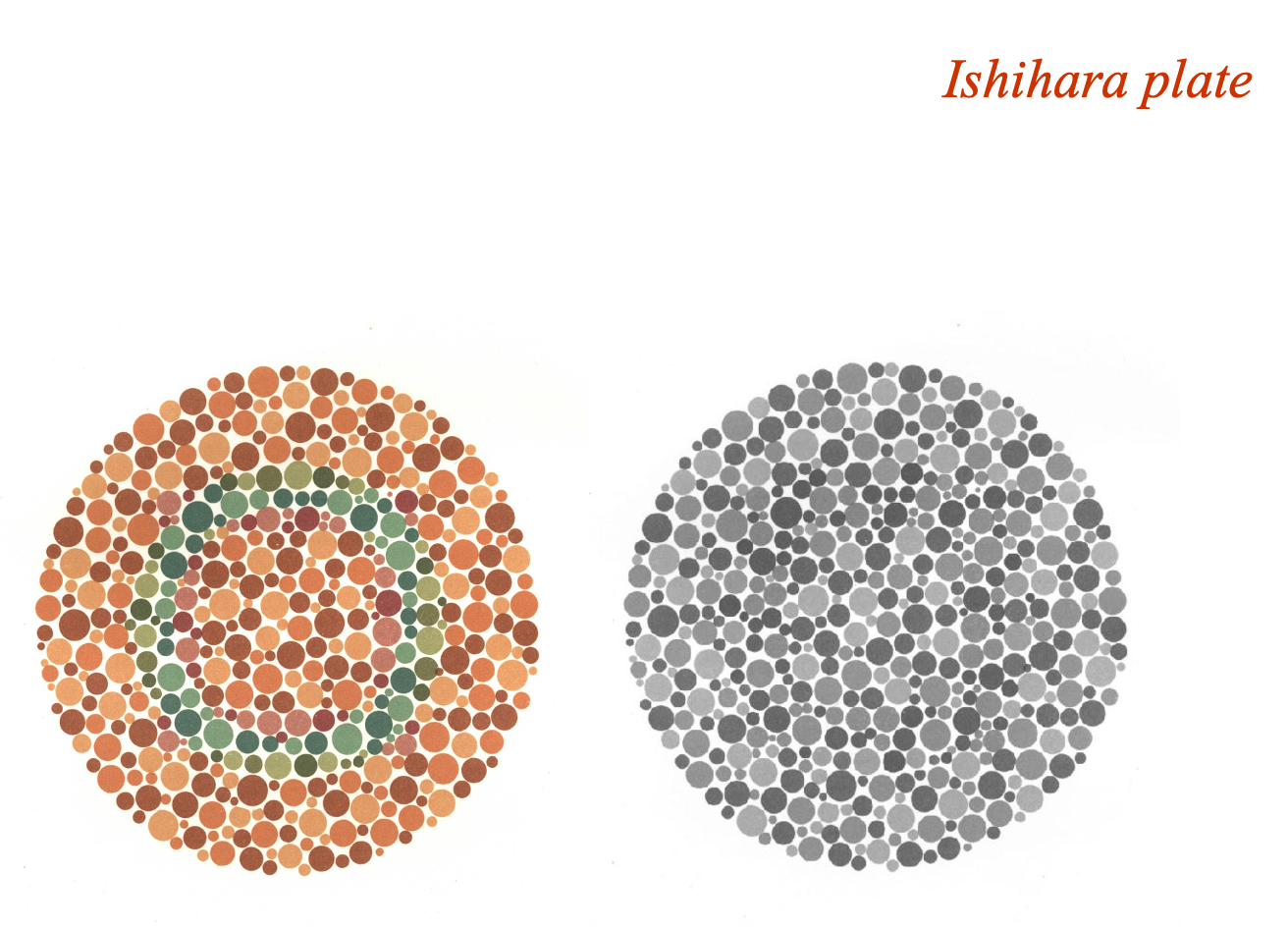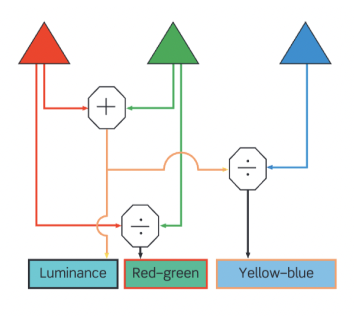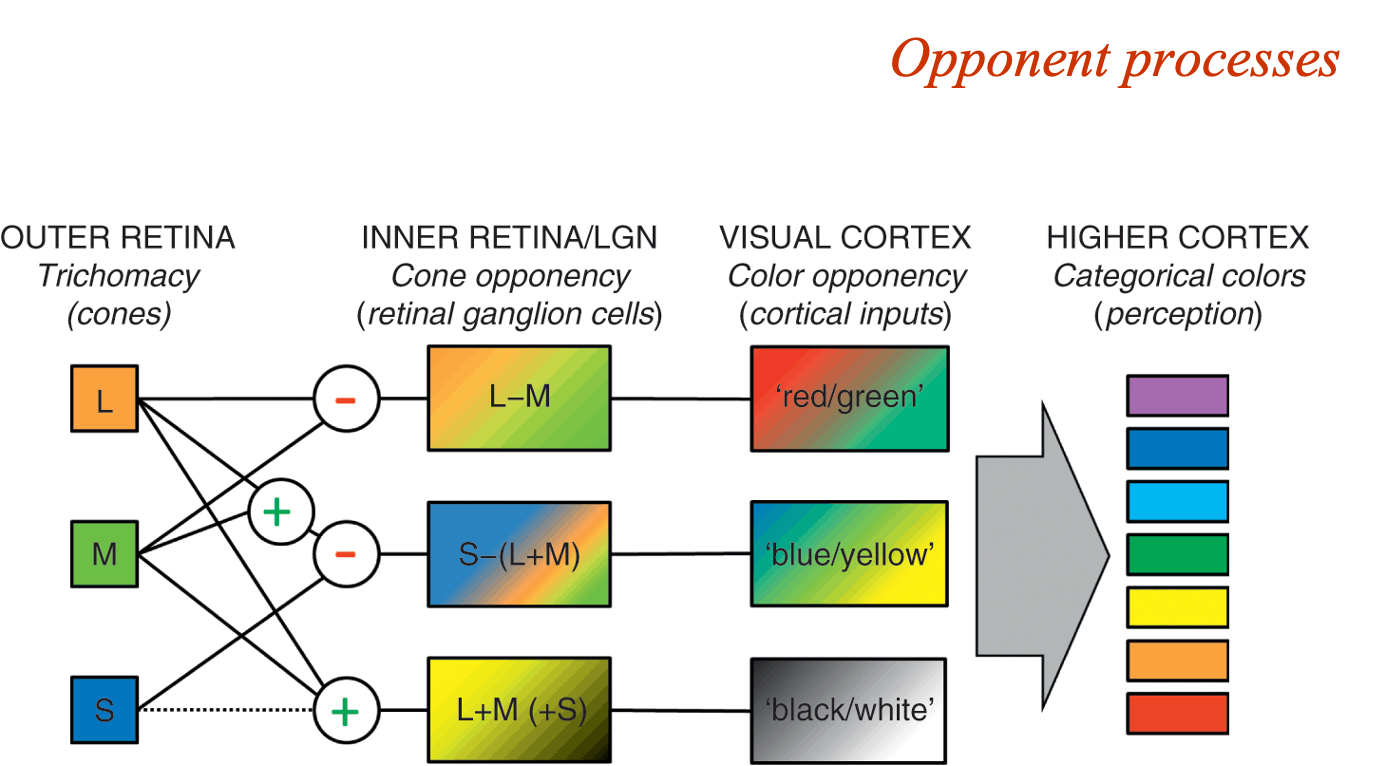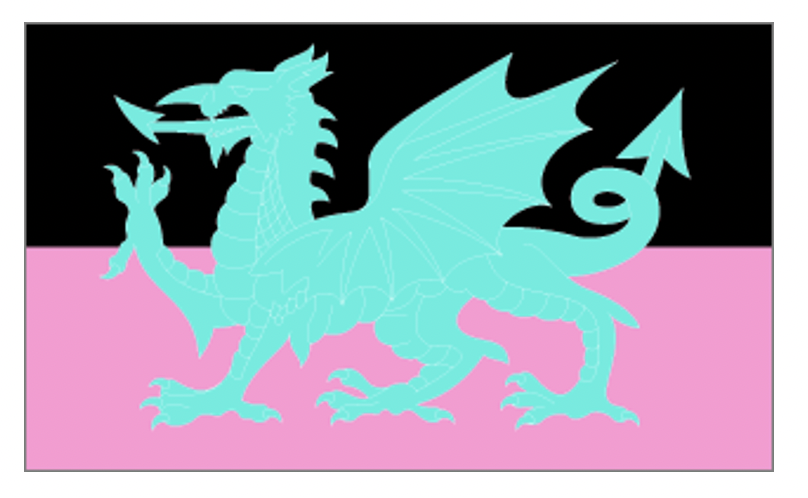Lecture 6- Colour vision
1/41
There's no tags or description
Looks like no tags are added yet.
Name | Mastery | Learn | Test | Matching | Spaced |
|---|
No study sessions yet.
42 Terms
There is nothing in the light that is actually…?
Coloured- colour is an invention of our brain
What is visible light?
Only part of the spectrum we can see
Nothing special about the light itself that makes it visible, it is visible because of our physiology
Depends on our eyes- snakes, for example, can see into the infrared part (produced by warm objects, like small furry creatures- their prey)
Wavelength varies smoothly and evenly. However, __ does not?
Our percept of colour
Colours seem to change quickly at some points and smoother at others
Colour doesn’t follow the same physics as light- it is due to our visual system
Why can’t we see infrared?
We have warm blood, and blood vessels in our retina
These would glow in the dark, so that would be all we see
Why can’t we see UV?
Many birds and insects can see into this part of the spectrum
However, it is damaging to our eyes and is filtered out by them
What is colour addition?
Light from the sun is white because it's made up of many different colours
Red ink reflects red light and absorbs the rest, for example (why it appears red)
What is Trichromacy theory?
3 torches (of almost any colour- has to be reasonably spread across the spectrum though)
Can make a perfect match by adjusting these torches
Require 3 things to match any colour of light
Seen with TV sets- screens are made up of a lot of tiny little dots that are either red, green or blue
Act as torches, making up the colours of your screen
Why do we need 3 torches to successfully match colour?
Because we have 3 types of cone in our head
Differential stimulation of these is what allows us to see colour
What is colour subtraction and when is it used?
Mixing paints results in colour subtraction (each point removes light of particular wavelengths)
Newspapers etc. use this technique
What are photoreceptors?
In our retina- absorb the light coming into the eye and turns it into an electrical signal
We have 4 types of photoreceptors. What are they?
Rods- very sensitive to light however poor spatial resolution (use them at night/when it's dark)
3 types of cones- short, medium and long cones (responsible for our colour vision)
What is the principle of univariance?
Any stimulus evokes a response whose strength is governed by both intensity and wavelength- this is a single number (univariant)
The problem with the system is that it can't tell the difference between changes in wavelength and changes in intensity
Our receptors can only vary their response in one way
The cell can only fire more or less, but the world can change in more than one dimension
Who struggles with this problem (of univariance)?
Animals with only one type of photoreceptor, and us at night
Can see differences in brightness but not in colour
Essentially you become 'colour blind' at night (colour only exists in our brains)
Principle of Univariance- what happens with a two receptor system?
Each stimulus activates both receptors but in different ratios
This ratio does not change with changes in intensity
So colour can be calculated by taking the ratio of activity in the two channels
Ratio of short: long (intensity is just them added together)
Two receptor system- describe in more detail how this ratio would be calculated
Light is very blue = blue cone is signalling very strongly, and the green cone less strongly
100 : 10 ratio for example (so we see blue)
Intensity would be 110 in this instance
Other way round, light would be equally as bright, but we would see it as green (separate mechanisms)
Two receptor system- when would you have the greatest colour-change sensitivty?
When this ratio is changing the fastest
Ratio, at some points, will be changing very quickly
Bigger the difference in ratio = easier it is to differentiate
What is acuity?
The degree to which fine detail can be resolved
What reduces visual acuity?
Introducing new cone types into many retinal locations
Why we only have a few S cones (so yellow cone acuity is not reduced too much)
What is chromatic aberration?
Short wave light (blue and violet) is always out of focus in the eye
Why we don't need that many blue cones (image is fuzzy anyway so don't need many cones which respond to that wavelength- no fine detail to be encoded)
The theory is that we really have two colour vision systems. What is the primordial system?
Most mammals are dichromatic- have few S cones and lots of M cones- a blue/yellow system
This system is phylogenetically old (500 million years)
A purely chromatic channel with little spatial resolution
Get it with very bright, violet lights (like Christmas tree lights)- see it as fuzzy, with some things not entirely in the right place (using this system)
The theory is that we really have two colour vision systems. What is the second sub-system?
About 10 million years ago the L cones split into two
Red/green system
Only old world primates (though nwps also have a similar system that evolved independently)
Co-evolved with certain fruits so that we could forage them
With this new system, the brain can work out that all the leaves (which vary randomly in luminance) are the same thing, and different from the red fruit
Blue cones are relatively __ compared to the red and green ones?
Rare (only about 10%)
There seems to be no blue cones in…?
The very centre of our vision (the central fovea)
Where blue cones are inserted, we lose acuity (sacrificed colour vision in order to maintain the greatest possible spatial acuity)
What are monochromats?
Only have 1 cone type, or just rods (very rare)
Can’t see colour at all
What are dichromats?
Can distinguish lots of colours, but aren't able to distinguish between certain pairs of colours that are distinguishable to a normal trichromat
Dichromats- what are protanopes?
Lack long wavelength cone
No red receptors/cones
Really struggle to differentiate green from red
Gene is on the X chromosome (if women have one that lacks these cones but not the other one, they won't have this difficulty)
1% males, 0.02% females
Dichromats- what are deuteranopes?
Lack middle wavelength cone
Same as protanopes but no green cones (still difficulty with red/green distinction)
1.2% males, 0.1% females
Dichromats- what are tritanopes?
Lack short wavelength cone
No blue cones (difficulty with blue/green distinction)
Very rare
Anomalous trichromacies- what is deuteranomaly?
Abnormal medium wavelength cone
'Green' cone has its peak sensitivity shifted more towards the red part of the spectrum
Makes them more sensitive to red light
4.9% males, 0.04% females
Anomalous trichromacies- what is protanomaly?
Abnormal long wavelength cone
'Red' cone has a different peak wavelength sensitivity to most people (towards the green part of the spectrum)
1% males, 0.02% females
What can cause an individual to be colour blind (2 things)?
Can be genetically inherited, and are also sex-linked (congenital colour defects much higher in men than women)
Also possible to acquire a colour-vision defect- blue (short wave) cones are vulnerable to diseases like diabetes (and from drug use)
How can you test for colour blindness?
Ishihara plate- set of blobs that vary in luminance and size (giving away no clues)
Most of us can immediately see that the change in wavelength reveals a figure (green circle)
Easy to report it (however people with red green colour blindness wouldn't see this)

What is opponent coding?
Responses of two cone types cause opposite changes to the activity of a neuron
E.g. red-green ratio is increased by higher activity from the red cone, and decreased by higher activity in the green
Opponent processes- our subsystems of colour vision make 2 comparisons. What are they?
Comparison of short with long/medium (blue yellow)- not spatially antagonistic- old, shared with other mammals- own ganglion cells, to koniocellular layers of LGN and then layers 2-3 of V1
Comparison of medium with long (red/green)- spatially antagonistic- new to old world primates- to parvocellular layers of LGN- layer 4ca of V1
Separate paths for these systems

Opponent processes- this system provides us with 3 signals. What are they?
Luminance signal- adding the signal from the red and green cones (blue cones don't seem to add anything)
Red-green colour signal- dividing the output of the red cones by that of the green (or vice versa)
Blue-yellow colour signal- dividing the output of the luminance signal by the output of the blue cones
Opponent processes- what happens in the higher cortex?
All sorts of comparisons start being made with different parts of the image (other colours are colours of contrast)

Give an example of the colour aftereffect
Stare at this image for 20 seconds, when shown a blank screen straight after, you see a faint image of the flag with the real colours
There seems to be a pattern in which colours cause certain colours to be seen in the aftereffect

Why does the colour aftereffect occur?
Adapting a patch of retina to a given colour reduces the sensitivity to that colour, and 'swings' each opponent channel towards its opposite extreme
E.g. adaptation to red causes white to appear green
What is cerebral achromatopsia?
Able to see fine detail but can’t see colour (just going off shape or feel)

How would someone with cerebral achromatopsia do in this task?
Can't tell which one is the odd one out in the left image (based on colour) but can in the right image (based on intensity)
What is colour constancy?
Our ability to work out ‘colours’ despite large changes in the wavelength of the illuminant (lighting)
The ‘dress’ illusion- colour you see depends on what your brain thinks the illumination is
How can the visual system tell that the colour remains constant even when the light changes?
The colour of an object is not only influenced by the light coming from that specific object, but also the light coming from other sources
Visual system looks at lots of objects at once
All reflecting lots of long (red) wavelengths = likely being illuminated by long (red) wavelengths so the system can compensate for this